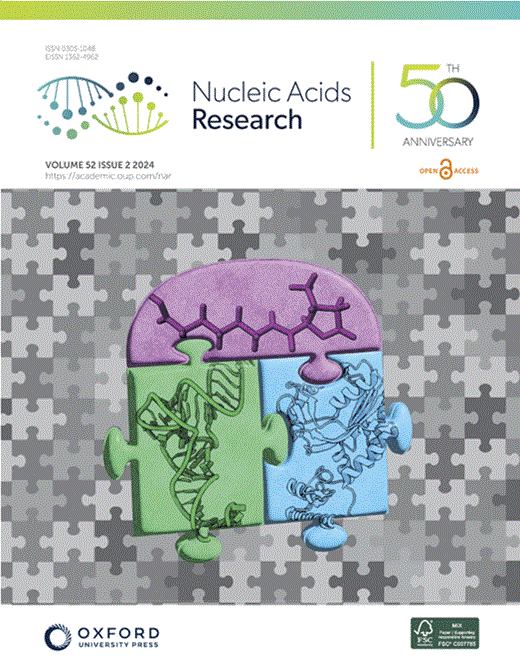A rational engineering strategy for structural dynamics modulation enables target specificity enhancement of the Cas9 nuclease.
IF 16.6
2区 生物学
Q1 BIOCHEMISTRY & MOLECULAR BIOLOGY
引用次数: 0
Abstract
Structural dynamics of an enzyme plays a crucial role in enzymatic activity and substrate specificity, yet rational engineering of the dynamics for improved enzymatic properties remains a challenge. Here, we present a new biochemical strategy of intermediate state stabilization that modulates the multistep dynamic mechanisms of enzyme reactions to improve substrate specificity. We employ this strategy to enhance CRISPR-Cas9 nuclease specificity. By incorporating positively charged residues into the noncatalytic REC2 domain of Cas9, we stabilize the REC2-DNA interaction that forms exclusively in a catalytically inactive intermediate conformation of the Cas9 complex. This enables off-target trapping in the inactive conformation and thus reduces off-target cleavage in human cells. Furthermore, we combine the REC2 modification with mutations in previous rational variants, leading to the development of a combinational variant named Correct-Cas9, which connotes "combined with rationally engineered REC-Two" Cas9. Assessed by high-throughput analysis at thousands of target sequences, Correct-Cas9 exhibits increased target specificity compared to its parental variants, demonstrating a synergy between our strategy and previous rational approaches. Our method of intermediate state stabilization, either alone or combined with conventional approaches, could be applied to various nucleic acid-processing enzymes that undergo conformational changes upon target binding, to enhance their target specificity effectively.合理的结构动力学调节工程策略可以增强Cas9核酸酶的靶特异性。
酶的结构动力学在酶活性和底物特异性中起着至关重要的作用,但合理地设计动力学以改善酶的性能仍然是一个挑战。在这里,我们提出了一种新的中间状态稳定生化策略,通过调节酶反应的多步动态机制来提高底物特异性。我们采用这种策略来增强CRISPR-Cas9核酸酶的特异性。通过将带正电的残基整合到Cas9的非催化REC2结构域中,我们稳定了仅在Cas9复合物的催化非活性中间构象中形成的REC2- dna相互作用。这使得脱靶捕获在非活性构象,从而减少脱靶切割在人类细胞。此外,我们将REC2修饰与之前的理性变体中的突变结合起来,从而开发了一种名为Correct-Cas9的组合变体,这意味着“与理性工程的REC2结合”Cas9。通过对数千个目标序列的高通量分析评估,与亲本变异相比,Correct-Cas9表现出更高的目标特异性,证明了我们的策略与之前的合理方法之间的协同作用。我们的中间状态稳定方法,无论是单独使用还是与常规方法联合使用,都可以应用于各种核酸加工酶在靶标结合时发生构象变化,有效提高其靶标特异性。
本文章由计算机程序翻译,如有差异,请以英文原文为准。
求助全文
约1分钟内获得全文
求助全文
来源期刊

Nucleic Acids Research
生物-生化与分子生物学
CiteScore
27.10
自引率
4.70%
发文量
1057
审稿时长
2 months
期刊介绍:
Nucleic Acids Research (NAR) is a scientific journal that publishes research on various aspects of nucleic acids and proteins involved in nucleic acid metabolism and interactions. It covers areas such as chemistry and synthetic biology, computational biology, gene regulation, chromatin and epigenetics, genome integrity, repair and replication, genomics, molecular biology, nucleic acid enzymes, RNA, and structural biology. The journal also includes a Survey and Summary section for brief reviews. Additionally, each year, the first issue is dedicated to biological databases, and an issue in July focuses on web-based software resources for the biological community. Nucleic Acids Research is indexed by several services including Abstracts on Hygiene and Communicable Diseases, Animal Breeding Abstracts, Agricultural Engineering Abstracts, Agbiotech News and Information, BIOSIS Previews, CAB Abstracts, and EMBASE.
 求助内容:
求助内容: 应助结果提醒方式:
应助结果提醒方式:


